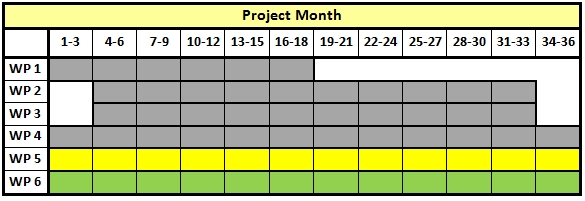WORKPLAN
To achieve the different objectives, the Collaborative project is structured in 6 workpackages (WP1-WP6).
Time Schedule

WP1-WP4 = research and technical work, WP5 = state of the art, knowledge management and dissemination, training, WP6 = management
Workpackages description:
WP1: Samples and tools. Selection, characterization and preparation of materials and set-up of tools.
Beneficiaries: KIT, JRC-ITU, JÜLICH, PSI, SCK-CEN, CNRS, CTM, AEKI, STUDSVIK.
WP leader: Dr. Volker Metz, KIT
The overall objectives are:
-
Provision of available experimental and theoretical data on high burn-up spent nuclear fuel (HBU-SNF) material; selection of those HBU-SNF materials for subsequent experimental investigations, where both (i) publication of key parameters is permitted by the fuel owners and (ii) the individual fuel history and irradiation characteristics are sufficiently know.
-
Preparation of selected HBU-SNF materials for subsequent characterisation as well as experimental investigations within WP2 and WP3.
-
Structural and chemical characterisation of selected HBU-SNF materials by means of electron microscopy and synchrotron-based methods in addition to macroscopic methods.
-
Documentation of the available experimental and theoretical data in addition to results of the characterisation of the selected samples.
WP2: Gas release + rim and grain boundary diffusion. Experimental determination of fission gases release. Rim and grain boundary diffusion experiments.
Beneficiaries: KIT, JRC-ITU, JÜLICH, PSI, CNRS, STUDSVIK.
WP leader: Dr. Detlef Wegen, JRC-ITU
The overall objectives are:
-
Quantification of fission gases and fission gas release in the various high burnup spent nuclear fuels (HBU-SNF) with respect to:
· grain boundaries
· radial distribution of fast released radionuclides (Xe, Kr, I, (Cs)) in spent nuclear fuel, fission gas release during corrosion experiments
· establishment of a data base on experimentally determined fission gas release.
-
Rim and grain boundary diffusion experiments resulting in:
· quantification of water penetration into the grain structures and subsequent
· corrosion/diffusion phenomena
· evaluation of corrosion rates with samples with and without grain boundaries
· quantification of the specific role of radiolytically produced H2 gas on the fast release fraction.
WP3: Dissolution based release. Dissolution based fast radionuclide release
Beneficiaries: KIT, JRC-ITU, PSI, SCK-CEN, CTM, AEKI, STUDSVIK.
WP leader: Eng. Karel Lemmens, SCK-CEN
The overall objectives are:
-
Quantification of the fast release of gaseous and non-gaseous activation and fission products into the aqueous phase during spent nuclear fuel leach tests, and to the extent possible, the determination of their chemical speciation.
-
The experiments will cover high burnup spent nuclear fuels (HBU-SNF) having burnup in the range of 50 to 60 GWd/tHM, different irradiation histories, reactor types and positions in the fuel rods.
-
The effect of different groundwaters will be investigated.
-
Special emphasis is given to the determination of IRF values of Cs, I, Se and 14C (from fuel and cladding) as well as to the Se(IV/IV) speciation.
-
Dissolution rates for relevant isotopes determined for damaged VVER fuel elements (to be disposed of in Germany, Hungary and Finland).
-
The results from experiments using fuel samples with/without cladding allow evaluation of the effect of the presence of the cladding material.
WP4: Modelling: Modelling of migration/retention processes of fission products in the spent fuel structure
Beneficiaries: KIT, AMPHOS21, JRC-ITU, CTM.
WP leader: Dr. Joan de Pablo, CTM
The overall objectives are:
-
Information on existing modelling tools, methods, and data bases at JRC-ITU
-
Initial speciation of rare fission products in LWR fuel, multiscale modelling of the migration / retention processes of fission products in the HBU spent fuel, in the cladding, and the estimation of the fission product total release through the spent fuel rod.
-
Modelling of the gas release on the different microstructures of the spent fuel pellet, the pellet gap, defects in cladding material as well as modelling of correlations between the gas release fraction and the fast release of non-gaseous fission products. A model development to predict diffusion processes through matrix grains will be performed.
-
Evaluation of the sensitivity of different parameters, such as diffusion coefficients, grain size distribution, macro-cracks patterns, etc.. These parameters are affected by the burn-up, FGR, fuel rim / pellet structures.
-
Initial speciation of 14C and other fast release elements as function of irradiation history, temperature, etc. to be used on estimation of expected concentrations in the experiments of WP 2 and WP 3. Thermodynamic approaches will be applied.
WP5: Knowledge, reporting and training: Documentation, State-of-the-Art report, up-date. Dissemination and Training
Beneficiaries: KIT, AMPHOS21, JRC-ITU, JÜLICH, PSI, SCK-CEN, CNRS, CTM, AEKI, STUDSVIK.
WP leader: Alba Valls, AMPHOS21
The overall objectives are:
-
Provide access to all scientific-technical results for all interested parties.
-
Providing training and education for the next generation of spent nuclear fuel specialists.
-
Scientific-technical results will be documented by compilation of the state-of-the-art at the beginning of the project. This report will be regularly updated with respect to the advances achieved within the project.
This WP includes also the management and dissemination of knowledge via various channels, the organisation of the annual project workshops and training activities
WP6: Project Management
Beneficiaries: KIT, AMPHOS21
WP leader: Dr. Bernhard Kienzler, KIT
The overall objectives are:
-
Establishment and maintenance of the key project administrative functions
-
Creation and maintenance of the consortium agreement, partner / membership structure and project membership: the consortium agreement will form the basis of all formal interactions between organisations in the project.
-
Collection of all technical and financial data, compilation and preparation of necessary documents to do the management and activity reporting of the project to the European Commission at project month 18 and 36.
-
Assessment of the project progress according to reports, deliverables and milestones expected.